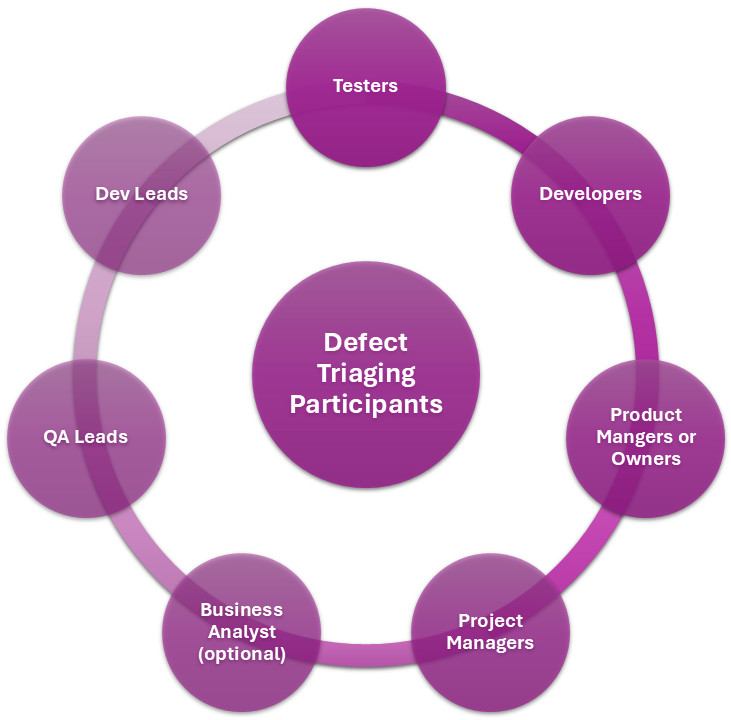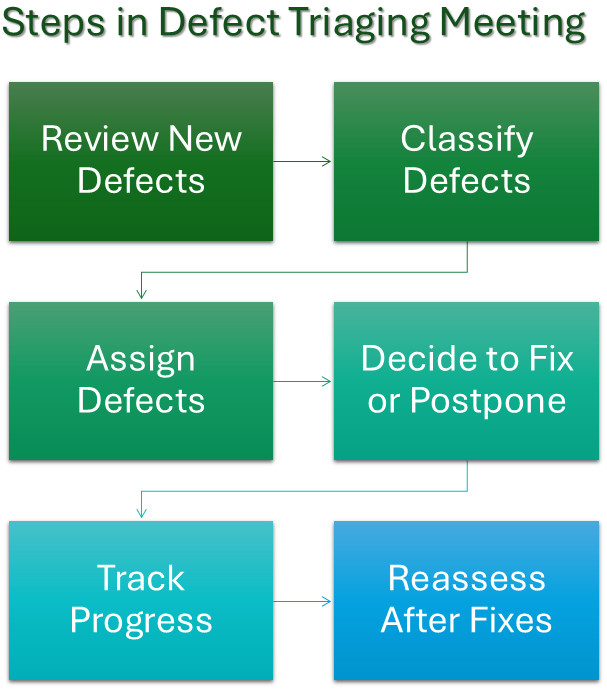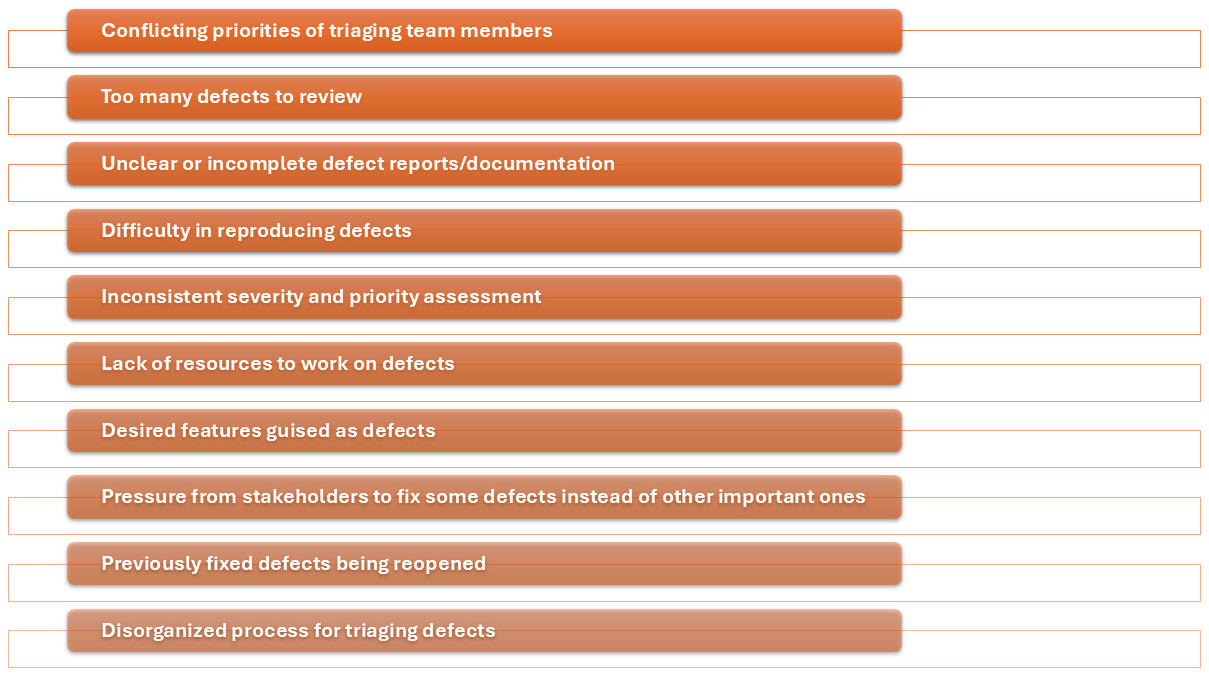Defect Triage in Software Testing
|
|
“Don’t fix bugs later; fix them now” – Steve Maguire.
This is an interesting, proactive approach to not just software testing but any aspect of one’s life. But the question that begs to be asked is – is everything worth fixing?
In the context of software testing, you might have a backlog of bugs and defects from the sprints that go by. As time goes by, the pile keeps growing. Now, if you revisit this pile, would you solve every single defect there? I don’t think so. You’d ask your manager or lead about the priorities, have some more discussions, and then probably pick up a few of the bugs. In your own way, you’ve triaged or sorted your workload. Luckily, in software testing, defect triaging is a thing – quite a useful practice, albeit a little time-consuming, some might think.
Let’s understand defect triaging and how to do it so that your head doesn’t explode the next time you revisit the “defects pile”.
Triage Meaning in Software
Triaging simply means sorting through things to figure out what needs attention first. It’s like when you go to the doctor with multiple symptoms: the doctor will prioritize which issue to treat first based on how serious it is. In software testing, triaging means looking at a list of reported bugs and deciding which ones are the most urgent or critical to fix right away and which ones can be handled later.
Defect triaging in software testing is the process of reviewing, prioritizing, and assigning defects found during testing. The goal is to determine which defects should be fixed first, which can wait, and which might not need fixing at all. This process will allow you to make sure that the most critical issues are addressed promptly.
Why do you Need a Defect Triage?
You might wonder why you should put in the extra hours to triage defects. Well, it has many long-term benefits:
- Helps Prioritize Important Issues: Not all defects are equal. Some may cause major problems, while others might be minor annoyances. By triaging, you can prioritize the defects that have the biggest impact on the software, users, or business goals. For example, a defect that causes the system to crash is more urgent to fix than a typo on a page.
- Efficient Use of Resources: Fixing defects takes time and effort, so you want to make sure that the development and testing teams are working on the most critical issues first. If you try to fix every bug immediately, your team might waste time on less important issues, while more severe bugs go unaddressed.
- Improves Quality of the Software: By focusing on the defects that have the most significant impact on the user experience or functionality of the software, triaging will help you improve the overall quality of the product. Fixing the major defects first makes sure that the software is stable, functional, and meets user expectations.
- Helps Meet Deadlines: Software projects often have tight deadlines. Triage helps manage defects in a way that helps meet these deadlines. By prioritizing high-severity defects, you can make sure that the most important problems are fixed in time for release, while less urgent issues can be handled later.
- Avoids Wasting Time on Non-Issues: Sometimes, a reported defect might not actually be a problem. It could be a misunderstanding, or perhaps it’s an issue that’s already been fixed, or even a feature request. Triage helps identify these cases early on, so time isn’t wasted investigating non-issues.
- Improves Communication: Triage involves collaboration between different teams – testers, developers, product managers, and sometimes business stakeholders. This helps everyone get on the same page about which defects are most important. Builds clear communication about what needs to be fixed and why.
- Prevents Backlog Build-up: If defects aren’t triaged regularly, they can pile up, creating a massive backlog of issues. This can overwhelm the team and make it harder to focus on fixing high-priority problems. Regular triage helps keep the defect list manageable and makes sure that things get fixed in a timely manner.
- Increases Customer Satisfaction: When defects are triaged effectively, the team can resolve the most impactful bugs quickly. This directly leads to a better user experience. Customers are more likely to be satisfied with a software product that works smoothly and reliably, rather than one with unresolved major issues.
How Often Should You Have Defect Triage?
You need to adjust the frequency of triaging depending on the size of your project, the speed of development, and how critical the defects are. Here are some common frequencies that people maintain for defect triaging.
- Daily Triage (Most Common): For most software projects, triaging defects once a day is the most common approach. This is especially true for active projects with a lot of testing and development work happening in parallel. Daily triage makes sure that the team stays on top of the defects as they come in and can address issues promptly.
- Triage After Every Test Cycle: In some projects, especially those that run automated tests or have regular test cycles, it’s helpful to triage defects at the end of each testing cycle. For example, if your team runs a test cycle every 2-3 days, it can be a good idea to triage defects after that cycle ends to decide what needs fixing before the next cycle begins.
- Triage Weekly (For Smaller Projects or Low Activity): In projects where defects come in more slowly, or if the software is relatively stable with fewer new issues, you might only need to triage defects once a week. However, this could mean that critical issues may take longer to address, so it’s not ideal for high-traffic or high-risk projects.
- Triage Based on Severity and Urgency: In some cases, you may need to triage defects immediately or as they come in, particularly for high-priority issues. For example:
- Critical issues (like system crashes, security vulnerabilities, or showstopper bugs) should be triaged and acted upon right away, ideally as soon as they’re reported.
- Major defects that affect key functionality or performance but are not immediately urgent might be triaged at the end of the day or after a specific testing session.
- Minor issues (like cosmetic defects or low-priority bugs) could be triaged on a weekly basis, or even later if resources are limited.
- Triage During Major Releases: Before major software releases or launches, triage should be done more frequently. This is to make sure that any defects discovered in the final stages are handled appropriately. It’s not uncommon to have triage sessions multiple times per day during the last week leading up to a release, particularly if many bugs are found.
- When New Defects Are Reported: If you have a continuous flow of new defects, it’s a good idea to triage as soon as they’re reported to assess their severity and priority. For example, if a new bug is reported during the day and the issue is urgent, you should triage it immediately to decide whether to fix it right away.
- As Part of Standups or Meetings: In some teams, triaging can be done during daily standups or meetings, where the team quickly reviews and decides what to do with defects reported in the past 24 hours. This can work well in Agile or Scrum environments, where regular updates and collaboration are key.
The Defect Triage Meeting
A team sits to triage defects because you need different perspectives to decide if a defect is worth pursuing or not. Participants usually include:
- Testers
- Developers
- Product Managers or Owners
- Project Managers
- Business Analysts
- QA Leads
- Dev Leads

This team comes together to analyze each bug in the bucket and decide what to do with it. Here’s the process they generally follow.

Defect Triage Process
Let’s look at how you can go about triaging defects.
Defect Discovery
The first step in the process is when a tester finds a defect. This could be anything from a crash, an incorrect result, a broken feature, or even a visual bug like a misaligned button. The tester records the defect in a defect tracking system (like JIRA or Bugzilla), with details such as:
- How to reproduce the bug.
- The severity (how bad the issue is).
- The environment where it occurred (browser, device, operating system).
- Any relevant screenshots or logs.
Defect Reporting
Once the defect is logged, it’s added to a list of all defects found so far. At this stage, the defect might be considered untriaged because the team hasn’t yet decided its importance or what to do with it.
Defect Review
The triage team (usually including developers, testers, and sometimes product managers) meets regularly to review the reported defects. In this step, they do the following:
- Understand the defect: The team reads through the details of the defect report to understand the problem, how it was discovered, and its potential impact on the system.
- Check for duplicate defects: Sometimes, the same defect may be reported multiple times. The team will check if the defect has already been logged and avoid redundant work.
Defining the Severity
The triage team will assess the severity of the defect. Severity refers to how serious the defect is in terms of its impact on the software. It’s typically categorized as:
- Critical/High: The defect causes major issues like system crashes or data loss, making the software unusable. It needs to be fixed immediately.
- Medium: The defect affects functionality but doesn’t stop the software from working. It should be fixed soon, but it’s not urgent.
- Low: The defect is minor, like a small UI glitch or cosmetic issue, and doesn’t significantly affect the user experience.
Assigning Priority
Next, the team decides the priority of the defect, which determines how quickly it should be addressed. Priority might be affected by factors like deadlines, release schedules, or whether the defect blocks other work. Priority can be:
- High priority: The defect must be fixed quickly because it impacts users or business goals.
- Medium priority: The defect is important but not urgent and can be fixed in the next cycle.
- Low priority: The defect can be fixed later, as it has minimal impact on the user experience.
Assigning Responsibility
After assessing severity and priority, the team assigns the defect to the appropriate person or team for fixing. For example:
- A developer may be assigned to fix a bug in the code.
- A tester might need to verify whether the defect is reproducible or if there is additional information needed.
- A product manager or business owner might help decide whether a bug should be fixed at all if it’s a minor issue.
Deciding on the Fix or Reject
In some cases, after triaging, the defect might be:
- Accepted and assigned for fixing: If it’s deemed to be an important issue, the team will plan to fix it as soon as possible.
- Rejected or postponed: If it’s determined to be low impact, not a real bug, or not worth fixing (e.g., a cosmetic issue with low visibility), it might be rejected, postponed, or moved to a future release.
Tracking the Fix
Once the defect is triaged and assigned, the team tracks its progress. The developers will work on fixing the bug, and the tester will verify if the issue is resolved once the fix is implemented. The defect tracking system will be updated to reflect its status (e.g., “In Progress,” “Resolved,” or “Closed”).
Re-testing and Verification
After the defect is fixed, the tester will verify the fix by running tests to make sure that the bug is no longer there and hasn’t caused new issues. If everything is working correctly, the defect can be closed. If the fix didn’t work or caused other issues, it may be re-opened, and the triage process might start again.
Throughout the triaging process, there’s constant communication between testers, developers, and stakeholders (like product managers). This makes sure that everyone is aligned on the status of defects, how they’re being addressed, and what the priorities are.
Read: Defect Lifecycle.
Challenges with Defect Triaging
When you put defect triaging to the test, you might encounter some challenges in trying to get the job done. Here are the common ones that can make the process seem too overwhelming.

Thumb Rules in Bug Triage
You will need some guidelines or thumb rules to navigate through the challenges faced while triaging defects. The following should help.
Fix Critical Defects First
- Rule: Always prioritize defects that block the system or stop the user from performing essential tasks.
- Why: Critical defects have the most significant impact. If the software crashes, causes data loss, or prevents users from completing important functions, then fixing these issues must be the highest priority.
- Example: A bug that crashes the software when a user clicks a button should be fixed immediately, while a typo in a less important section can wait.
Severity Determines Priority
- Rule: The severity of a defect helps you decide how bad it is (e.g., a crash vs. a visual bug), and priority helps you decide how soon it should be fixed.
- Why: Some defects might not be critical but can still impact user experience or performance.
- Example: A defect that prevents payment processing on an e-commerce site should be given higher priority than a cosmetic issue in the footer.
High Priority = High Impact
- Rule: Defects that have a high impact on users or business operations should be fixed immediately, even if they are not technically critical.
- Why: Defects with high business impact, like preventing customers from making purchases or preventing users from accessing important data, should be addressed right away.
- Example: If a defect affects a feature that directly impacts revenue (e.g., a payment gateway), it should be given high priority, even if it’s not technically a critical error.
Don’t Waste Time on Minor Issues Early On
- Rule: Leave low-severity, non-blocking defects for later unless there’s ample time.
- Why: It’s tempting to fix small, minor issues like a misplaced button or a slight visual issue, but doing so can waste time and resources when there are more important defects to address.
- Example: A typo in a help section is less urgent than a bug that prevents users from submitting a form. Leave the typo for later.
Avoid Duplication of Efforts
- Rule: Check if a defect has already been reported before starting work on it.
- Why: Defects can be reported multiple times by different team members. If the defect has already been logged, there’s no need to triage or fix it again.
- Example: If two testers report the same bug, it should be identified as a duplicate in the triage meeting, and only one team should work on fixing it.
Don’t Ignore User-Reported Bugs
- Rule: Listen to feedback from users and take user-reported defects seriously.
- Why: Even if the defect seems minor or isn’t easily reproducible, it might be something affecting real users, and ignoring it could hurt customer satisfaction.
- Example: A user reports a slow loading time on a specific page. It may not seem like a major issue at first, but it could affect the user experience and should be investigated.
Check for Workarounds
- Rule: If there’s a workaround for a defect, it may be a lower priority to fix immediately.
- Why: If users or the system can continue working by using a temporary fix or bypassing the problem, it’s less urgent to fix. This gives you time to focus on more critical issues.
- Example: If a defect prevents users from using one feature but they can still perform the task manually, it’s lower priority compared to a bug that completely prevents a task from being performed.
Fix Existing Known Bugs Before New Features
- Rule: Do not start working on new features until all critical and high-priority defects have been addressed.
- Why: New features can introduce even more bugs, and ignoring defects can build up a backlog, delaying release timelines. Make sure the software is stable before adding new functionality.
- Example: If the software has critical bugs, don’t start working on the next big feature until those bugs are resolved.
Don’t Ignore Regression Defects
- Rule: If a defect breaks previously working functionality, it should be treated as a high priority, even if it seems less severe.
- Why: Bugs that cause regressions (where something that used to work fine now doesn’t) often have a bigger impact on the stability of the product and can cause confusion or frustration among users.
- Example: If a new update causes a button that was previously functional to stop working, it should be prioritized because it’s a regression of existing functionality.
Document Defects Clearly
- Rule: Make sure that defects are well-documented, with clear steps to reproduce and enough details for developers to understand.
- Why: A defect that’s not clearly documented can slow down the process of fixing it. Developers need clear instructions to understand the problem and how to resolve it.
- Example: A defect report should include the steps to reproduce the issue, screenshots, expected vs. actual results, and any error messages.
Conclusion
You can learn a lot about your application when you triage defects. You’ll see defects raised by customers that tell you their pain points or hopes from the application and other nuances that should be addressed for a high-quality product. Use this opportunity to gain this insight, even if it means adding a few more processes to your operations! You’ll be thankful for opting to do this in the long run.
Additional Resources
- Defect Clustering in Software Testing
- Defect Cascading in Software Testing – A Guide
- Latent Defects Decoded: The Hidden Perils in QA
- Masked Defects Uncovered: Shining Light on the Hidden Flaws
- The Strategy to Handle Defects in the Agile Development Methodology
- When to Stop Testing: How Much Testing is Enough?
- The QA Professional’s Guide to Managing Production Bugs
| Achieve More Than 90% Test Automation | |
| Step by Step Walkthroughs and Help | |
| 14 Day Free Trial, Cancel Anytime |












